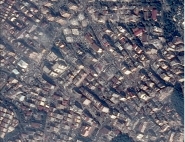Ground movements
Landslides
A landslide is an unstable slope of a mountain or hill that breaks away and slides down the slope. The volume of the landslide depends on the surface area and depth of the rupture. Massive movements of several million m³ can modify the landscape of an area dramatically. Most of the time, their displacement speed is a few mm or cm per year, but they can undergo violent acceleration (a few metres per day) and particularly degenerate into earth flows when they come into contact with water (heavy rainfall, snowmelt, etc.). This is when they are the most dangerous.
Earth flows
Earth flows are characterized by matter being transported in a more or less liquid form on slopes or in river beds. Often fast moving and extremely dangerous, earth flows are triggered by an excessive amount of water (exceptional rainfall, glacier or snow melt, etc.). They can be classified into three major categories:
- mudslides or "slides of liquid earth", which are very often a consequence of deforestation. The top soil layer, when subject to heavy rainfall, breaks away and slides down the slope in a viscous flow,
- torrential slides, which travel down river beds and carry matter with them during flood periods. The volumes transported can be considerable (several hundred thousand m³) and their consequences devastating,
- lahars (Javanese term) are mudslides of volcanic rock debris. Their destructive effects are greater than the eruptions that precede them.
Rock falls (boulders and blocks)
Rock falls are caused by cliffs or rocky slopes breaking up. They have a different name depending on the volume of falling matter:
| Stone falls | < 0,1 m³ |
| Boulder falls | between 0,1 m³ and 100 m³ |
| Rockslide | between 100 m³ and 10,000 m³ |
| Major rockslide | between 10.000 m³ and 10 millions m³ |
| Catastrophic rockslide | > 10 millions m³ |
All low volume movements (up to a few thousand m³) have their sudden nature and high speed in common. High volume (more than one million m³) rock mass fractures are more complex and can take place over decades once deep cracks have appeared.
Subsidence, ground collapse and cave-ins (risk not due to natural causes)
Man has often had to dig beneath dwelling places to provide the raw materials for new buildings, or to extract veins of coal or potash or to pump up underground fluids or gases. When created, these cavities do not generally represent a danger for the surface. They have a more or less solid roof, which as time passes, undergoes constraint due to its weight, age and the infiltration of water. When these cavities are very deep (more than 1000 m deep in the case of many coal mines), depth is generally sufficient for ground settling to be stable. However, the cavities can sometimes cause subsidence which can damage buildings and piping. When the cavities are much closer to the surface (e.g. chalk or gypsum quarries), water erosion and natural wearing of the rock can sometimes lead to collapse of the quarry roofs and the land above them caving in.
In France, Paris and its suburbs provide a perfect illustration of the dangers of old abandoned quarries. Limestone, chalk and gypsum were intensively exploited during previous centuries, and now the Paris substrata are full of "holes". The northern and eastern parts of France are also affected by subsidence (the caving in or collapse of relatively large areas of land) due to coal, iron and salt mining, etc.
Packing and swelling-shrinking
The Earth's substratum is full of rivers, underground lakes and water tables, all of which play an active part in the water cycle. In humid areas, (marshes, swamps, lagoons, etc.) some clay or peat soils can swell up and become packed due to the effect of the water, or on the contrary, a drought. Both cases can have serious consequences for buildings if we are not careful.
